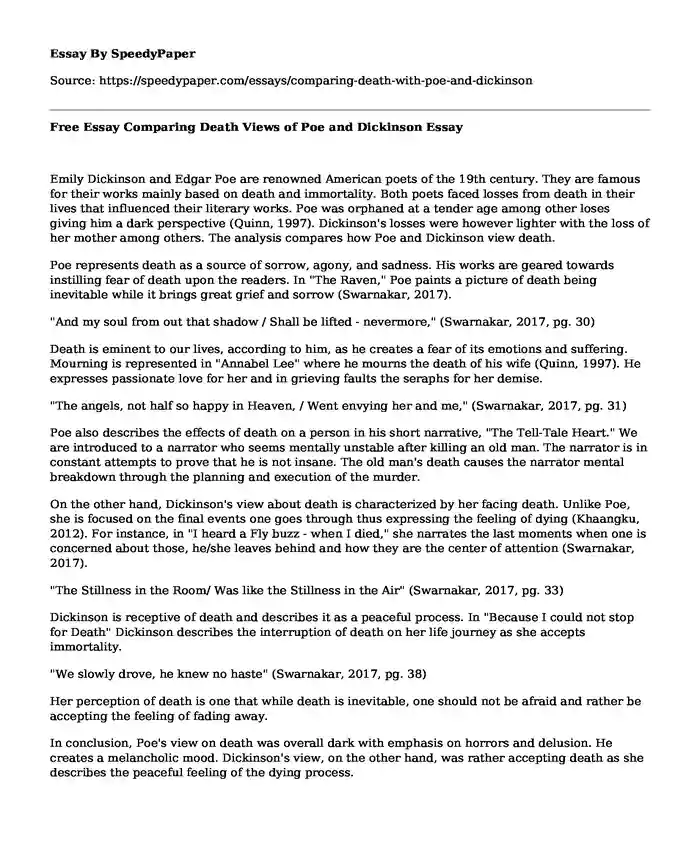
| Type of paper: | Essay |
| Categories: | Emily Dickinson Edgar Allan Poe |
| Pages: | 2 |
| Wordcount: | 491 words |
Emily Dickinson and Edgar Poe are renowned American poets of the 19th century. They are famous for their works mainly based on death and immortality. Both poets faced losses from death in their lives that influenced their literary works. Poe was orphaned at a tender age among other loses giving him a dark perspective (Quinn, 1997). Dickinson's losses were however lighter with the loss of her mother among others. The analysis compares how Poe and Dickinson view death.
Poe represents death as a source of sorrow, agony, and sadness. His works are geared towards instilling fear of death upon the readers. In "The Raven," Poe paints a picture of death being inevitable while it brings great grief and sorrow (Swarnakar, 2017).
"And my soul from out that shadow / Shall be lifted - nevermore," (Swarnakar, 2017, pg. 30)
Death is eminent to our lives, according to him, as he creates a fear of its emotions and suffering. Mourning is represented in "Annabel Lee" where he mourns the death of his wife (Quinn, 1997). He expresses passionate love for her and in grieving faults the seraphs for her demise.
"The angels, not half so happy in Heaven, / Went envying her and me," (Swarnakar, 2017, pg. 31)
Poe also describes the effects of death on a person in his short narrative, "The Tell-Tale Heart." We are introduced to a narrator who seems mentally unstable after killing an old man. The narrator is in constant attempts to prove that he is not insane. The old man's death causes the narrator mental breakdown through the planning and execution of the murder.
On the other hand, Dickinson's view about death is characterized by her facing death. Unlike Poe, she is focused on the final events one goes through thus expressing the feeling of dying (Khaangku, 2012). For instance, in "I heard a Fly buzz - when I died," she narrates the last moments when one is concerned about those, he/she leaves behind and how they are the center of attention (Swarnakar, 2017).
"The Stillness in the Room/ Was like the Stillness in the Air" (Swarnakar, 2017, pg. 33)
Dickinson is receptive of death and describes it as a peaceful process. In "Because I could not stop for Death" Dickinson describes the interruption of death on her life journey as she accepts immortality.
"We slowly drove, he knew no haste" (Swarnakar, 2017, pg. 38)
Her perception of death is one that while death is inevitable, one should not be afraid and rather be accepting the feeling of fading away.
In conclusion, Poe's view on death was overall dark with emphasis on horrors and delusion. He creates a melancholic mood. Dickinson's view, on the other hand, was rather accepting death as she describes the peaceful feeling of the dying process.
References
Khaangku, P. (2012). The images of death in Emily Dickinson's Poetry (Doctoral dissertation).
Quinn, A. H. (1997). Edgar Allan Poe: a critical biography. JHU Press.
Swarnakar, S. (2017). Representation Of Death In Edgar Allan Poe and Emily Dickinson. A Cor das Letras, 8(1), 29-42.
Cite this page
Free Essay Comparing Death Views of Poe and Dickinson. (2022, Feb 21). Retrieved from http://land-repo.site.supplies/essays/comparing-death-with-poe-and-dickinson?pname=speedypaper.com
Request Removal
If you are the original author of this essay and no longer wish to have it published on the SpeedyPaper website, please click below to request its removal:
- Free Essay Finding Positive Social Changes with Education
- Essay Example on Social Stratification
- Essay Sample on the Impact of Mobile and Cloud Technology on Business
- Reflection Essay Sample on Abundance: The Future Is Brighter Than You Think
- Language and Individual, Essay Sample for Everyone
- Employee Engagement - Free Essay Example
- Comparison Essay Sample: Healthcare System in the U.S. and Japan
Popular categories




